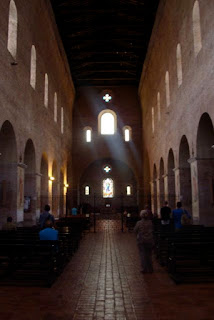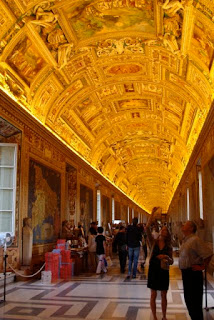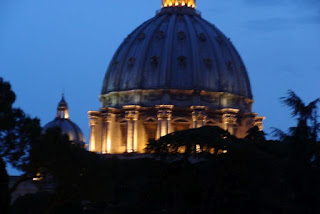Speculum mundi
After my siesta, I get up and get ready for an evening visit to the
Musei vaticani. On Friday evenings, they open it up from 7 to 11. It's still crowded, but not as much. Last time I went with my daughter, Anna, we got our tickets and got inside and Anna indicated that she wanted to sit down and talk first. So we did. "Dad," she said slowly and deliberately, "I don't do museums with anybody!" "Great," I replied, "I'll see you back here at 4:30." And that's the way it was. Even if Arthur had been here, we would have made the same arrangement.
I cross the Tiber at
Ponte Sisto, and walk over to Trastevere, but continue my trip on the bank of the Tiber. Somewhere along here, Queen Christina of Sweden lived after she abdicated her throne, and renounced her Lutheran ways. I wonder what she would think now? I am going this way because on Monday, I have to navigate over to the Residence where our meetings are being held. This walk, however, still does not give me the picture. There are these hills, you see, just south of the Vatican (itself a hill) and that complicates things.
I walk across the great square by Bernini, all cleaned up on the south side and being cleaned on the north. It is marred a bit by huge television screens. It is heartening to realize that they realize that the space is for the Word. Still... Once I've wended my way to the entrance to the museums, I stand in line, and unfurl my on-line receipt. The woman next to me kindly informs me that because I got tickets on-line, I have priority entrance, so I move to a much shorter line.
Truly these museums are a mirror of the world, from the works from New Guinea, that line the unique spiral that takes you to the museums from the lower entrance, to the ancient works that I do take some time with. Normally, I would have spent a great deal of time with the Egyptian collection, but I've seen this before, and just saw the materials in Berlin in the Fall, so I fly over to the Roman things. The power of this torso is just amazing to me even, or perhaps because of its present state. It dominates the room.
Apollo Belvedere is being worked on, and was not available for viewing.
Schade.
My memory of these museums is dominated by the ceilings. There is the magnificence of the Rafael ceilings, but this time I am taken especially by the ceiling of the long hallway that forms the Gallery of the Maps. It is golden in the evening light, and many are not looking at the maps at all, but are photographing or just staring at its beauty.
The maps themselves are interesting, especially a map that was done up to show all the Etruscan sites, known at the time, along with their place names. It was fascinating. It's also interesting to see what the cartography of the time was like, especially with sites known to me - the cities of Italy, and how they were depicted then.
You'll notice in the photograph that the windows are open. This is not seen much in other museums, but here one could be gazing at the golden heavens, or looking at the blue-green of the maps, or gaze outside to the Vatican Gardens, cypress with its special green and the deepening blue of the skies.
(To myself the other day: "I can't believe I'm watching this horrible Borgia series on television!") But I did, and so I take special notice of the Borgia apartments. Not a sumptuous as I would have thought, but the ceilings are magnificent. Unlike the Gallery of the Maps ceiling where you wonder, "How in the world did they do that?!", in the Borgia apartments you see exactly how they did that. The placement of the wood, the carving, the cross pieces that actually bear a load - it's all very human. I suspect Alexander VI would not have been happy with that observation.

Yes, I saw all of the Rafael, and took photos as well. What I really want to comment on is the contemporary collection which everyone blows off, quickly passing by to hurry their way to the Sistine Chapel. Another photographer and I agreed that they didn't know what they were missing. Perhaps they don't know these artists. I hope you will permit me a few photographs of works that stood out for me. I didn't remember this collection as being as extensive as it is. Here you can see Otto Dix, Emile Nolde, Botero, Sutherland, Dali, Bacon, Braque, Epstein, Barlach, Le Corbusier, Münch, Stein, Burchfield, Orozco, and many others. I expected some Manzu, since he did the doors to the basilica, but he was not in the exhibited collection.
Here is the processional cross, or another version of it the Henri Matisse did for the Chapel at Vence, France. There are full cartoons of two of the windows for the chapel, and a wonderful Madonna that is shown below:
Here is the stoning of St. Stephen by Orozco. What fascinated me by these works was whether these gifts were a reflection of personal faith or not. Were they political, might the Orozco have a sub theme here? Or were they somehow a reflection of their own journey of faith and life. Given that task, I find that these works are a delightful read, and heartening in their insights. Like religious music, there are so many levels here.
I am a real fan of Francis Bacon and his compatriot Lucien Freud. I was delighted to find a study by Bacon for his rather irreverent series on Innocent X and the portrait by Velasquez. Here it is before it is shredded, stretched, and scratched in the further paintings in this series. It is almost calm, as if waiting but not realizing the violence that was to follow. Did Bacon give this to the Papacy, or did the collection acquire it. I wonder. If Bacon gave it, I wonder why? Was it a poke in the eye, or a
homage?
From this collection I went upstairs to the Sistine Chapel, crowded, noisy (shushed from moment to moment), one really wants to lie down of the floor to take it all in. But you can't. I realized this conundrum about life once at Salisbury Cathedral. A friend and I wanted to know the best place to sit so that we might be able to take in all the beauty of the processional liturgy. It was plain to us. We simply couldn't, and having made that realization, enjoyed and savored what we could. So it was here. I had forgotten, or like most people probably never saw the series of paintings below the Michelangelo that were done by Botticelli. They are interesting, but really have a different plan about them. They are static in comparison with the sweep of the Michelangelo. In Florence, the last time, at the
Uffizi, I realized that I really don't like the "fuzziness" of Botticelli. I don't hate his work, it's just that he doesn't have that much to say to me anymore.
I love ivories, and especially Byzantine ones. They were so influential in the Carolingian and Merovingian eras - making statements, although subtle, about the pretensions of these families. Thus reflected back to us are an image of Rome long in decline but still influencing the developing nation states of Europe. A fascinating book to read in this regard is Chris Wickham's
The Inheritance of Rome - Illuminating the Dark Ages, 400 - 1000. It is that influence that overwhelms me every time that I come to Rome. Their law, their religion (before Christianity), their artistic forms (both their own and those modified, or taken from the Greeks), and their virtues and their vices all flow down to us. Now if we only understood, and explored that reality. Meanwhile, back at the ivories, isn't this beautiful - the precision of the carving, the color, the softness of the light. I found this collection to be very engaging, along with Medieval metal craft, and glass work.
The day has faded, and in the night light, the gardens and the palaces take on a different light. I sit for a time, just resting, in the
Cortile della Pigna. Many others are well, some having a buffet offered the right of the "pigna". I go back in and attempt a revisit of some galleries, but I have given this four-hour window it's best. My feet are killing me, and all I want at this point is dinner. I am feeling a bit like what the following photo suggests, a stretching
Laocoön, minus the snakes and threatened sons.
I walk over to the Tiber and cross on the
Ponte Vittorio Emmanuele, and immediately get lost on the other side. The fun of getting lost is that you see things and know relationships that you can use later. I find a not-so-crowded restaurant and have a delightful meal of
Caprese, filleto al peppe verde, and
baba con fragile. Italian waiters are a riot. They ranged this evening, from dismissive, to highly attentive (when I indicated that I liked the food - even the chef came out) to forgetful, especially when women were nearby, and finally almost weeping as I left. Wonderful!


























































